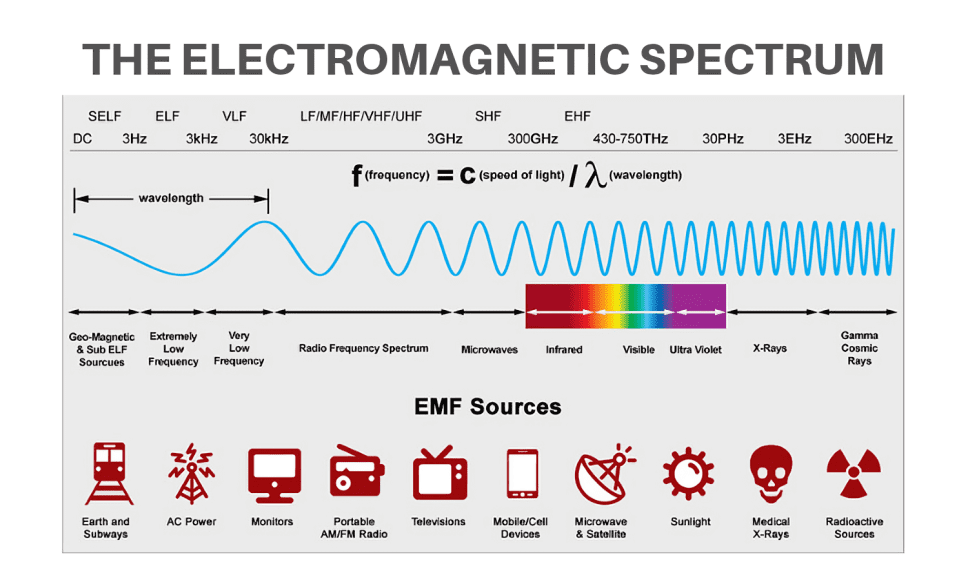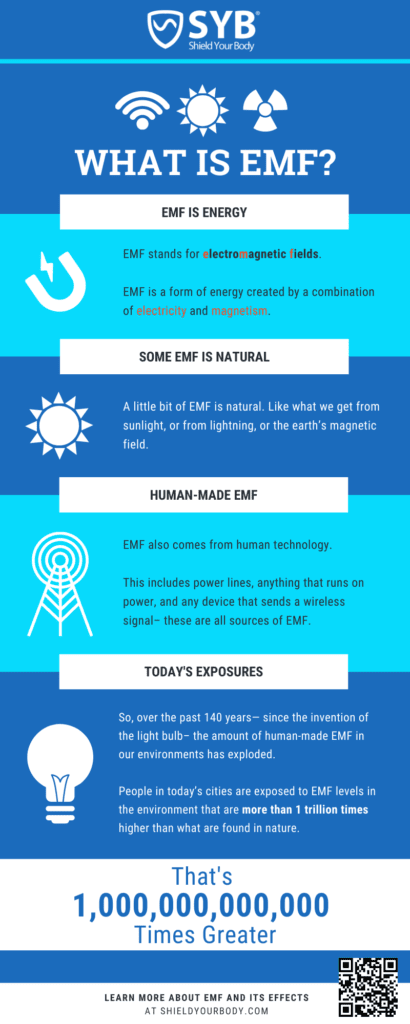Key Takeaways
-
Different types of EMF matter: Human-made EMFs are more bioactive and potentially harmful than natural EMFs like sunlight.
-
Simple distance reduces risk: Keep devices away, turn off WiFi at night, and use wired accessories to lower exposure.
-
Protective gear helps: Use shielding tools like phone pouches, laptop pads, and protective clothing when close contact is unavoidable.
EMF radiation"Radiation" in the context of Electromagnetic Fields (EMF) refers to the process by which energy is emitted and transmitted through space or a material medium in the form of electromagnetic...: Some people fear it, others ignore it, and most go about their lives without really knowing what it is. Not really the right approach, to be honest.
Today, EMF surrounds us everywhere we go, and science shows it has real effects on our health. So, ignoring it isn’t an option.
As for fear, once you finish this guide, you’ll realize there’s no need to be afraid. All you need is to understand EMF better and take simple steps to protect yourself.
So, let’s begin.
What Is EMF Radiation?
EMF stands for “electromagnetic fields.” It’s an energy"Energy" is a fundamental concept in physics, often described as the ability to do work or cause change. In everyday terms, it's what is needed to move things, heat them... produced when electric and magnetic fieldsDefinition and Nature of Magnetic Fields Magnetic fields are a fundamental aspect of electromagnetic fields, produced by moving electric charges (electric currents). The strength of a magnetic field is measured... come together. Technically, it’s a byproduct of electricity.

Want to Slash Your EMF Health Risks?
Want to Slash Your EMF Health Risks?
Good! Learn the one small change you should make right now.
When electrical energy moves in a circuit, it creates invisible waves of energy around the wires, devices, and anything electric.
So, in short, whenever electricity flows, EMF is generated.
But humans are smart. We’ve learned to use EMF for things like WiFi, cell phones, and other technologies that rely on it to send signals and keep us connected.
EMF isn’t just human-made, though. Nature produces it, too.
For example, sunlight is a natural form of EMF, as are the Earth’s magnetic fieldIn the context of electromagnetic fields (EMF), the term "field" refers to a region in space where electric and magnetic forces are exerted. An electromagnetic field is generated by electrically... and lightning. So, EMF has always existed in the world around us.
That’s why we often use the term “human-made EMF”—to draw a distinction between the natural forms of EMF and the kinds we’ve invented to power"Power" in a scientific context refers to the rate at which work is done or energy is transferred. In simpler terms, it's how fast something is using energy. For example,... our modern lives.
The Two Categories of EMF Radiation
So now that you’ve learned what EMF is, there’s one more thing that you need to understand, and that’s the difference between ionizing and non-ionizing radiation.
When most people hear the term “radiation,” they immediately think of nuclear radiation from disasters like Chernobyl and Fukushima.
But radiation comes in different forms and intensities and is part of the huge electromagnetic spectrumThe electromagnetic spectrum encompasses the entire range of electromagnetic radiation, which varies in wavelength and frequency. This spectrum includes, in order of increasing frequency and decreasing wavelength, radio waves, microwaves,....
The Electromagnetic Spectrum
The electromagnetic spectrum is basically a way of classifying different types of electromagnetic radiationElectromagnetic radiation refers to the waves of the electromagnetic field, propagating through space, carrying electromagnetic radiant energy. It includes a wide range of electromagnetic waves, from very long radio waves....
Let’s take a look at some of the key EMF types on the EM spectrum, starting from the left, where we have the lowest frequency"Frequency" in the context of electricity, Electromagnetic Fields (EMF), and wireless communication, can be thought of as the number of times something happens in a second. Specifically, it refers to... (longest waves).
Extremely Low Frequency (ELF): Household electricity and electrical appliances emit this type of EMF radiation. As the name suggests, it’s very low, with frequencies ranging from 3 to 30 Hz.
Radio Frequency (RF): We’re all familiar with Hz because it’s used to identify the frequencies used by radio stations. If you’re listening to 88.9 FM, they’re broadcasting EMF radiation at 88.9 MHz (megahertz).
Your radio is using its antenna to “tune in” to listen to that specific frequency of EMF radiation. It’s not just for radios, though. All wireless devices use radio frequencies to communicate.
Yes, that includes your WiFi router, cell phone, baby monitor, BluetoothFrom the perspective of someone concerned about the health effects of electromagnetic radiation, understanding Bluetooth radiation is crucial, especially in our increasingly wireless world. Bluetooth technology, ubiquitous in our daily... headset, and so on. RF covers the range of 3 kilohertz (3 kHz) to 300 gigahertz (300 GHz).
Then there’s the visible light range, which consists of all the colors of light you can see, immediately followed by infrared light, which isn’t visible to the naked eye.
After this, we move to ultraviolet radiation that comes from the sun. Then there are X-rays and gamma rays.
See this picture for more clarification.
So, as you see, “radiation” isn’t just one thing. But just like there are different types of radiation, their effects are also different.
This is why the electromagnetic spectrum is also divided in two different sections: ionizing and non-ionizing radiation.
Ionizing Radiation
Radiations like X-rays, gamma rays, nuclear radiation, and even ultraviolet radiation sit in the ionizing section of the electromagnetic spectrum.
These radiations have the power to knock electrons off your atoms, and cause severe damage in a short amount of time.
This is why you aren’t allowed to go to the Pripyat Amusement Park, which is an abandoned amusement park near Chernobyl, Ukraine.

This area has so much ionizing radiation"Ionizing radiation" refers to a type of electromagnetic radiation that carries enough energy to liberate electrons from atoms or molecules, thereby ionizing them. This form of radiation is part of... that if you stay there for some time, it can severely damage your cells, leading to issues like DNA damage and even cancer.
In some cases, staying in an irradiated area like that can even be fatal.
Non-Ionizing Radiation
Non-ionizing radiation, as the name suggests, doesn’t have the energy to knock electrons off your atoms. Therefore it isn’t instantly harmful like ionizing radiation.
This is why we use non-ionizing radiation to power our everyday lives.
But what you need to understand is that everything can be dangerous if taken in excess.
Everything Can Be Dangerous in Excessive Quantities
The amount of human-made radiation in our environment today is just too much compared to even a few decades ago – much less 150 years ago, when there was none.
Today, our phones are smart, our homes are smart, our refrigerators—well, that never really took off, but a lot of things in our lives are “smart.”
And everything “smart” makes its own EMF and puts it out into your surroundings.
We’ll talk more about this in a bit, but let’s first answer a question that I’m sure is popping into your mind:
If EMF is so harmful, then why don’t the natural sources—like sunlight, which we’re exposed to daily—harm us?
Effects of Natural Vs. Artificial EMFs
As one peer-reviewed study published in the journal Scientific Reports notes, our exposure to natural sources of EMF (like sunlight) is usually “of significantly higher intensities/energy and longer durations” than our exposure to man-made EMF.
And yet, at normal levels, natural EMFs don’t harm us. (A healthy dose of sunlight is, for example, vital to our wellbeing—though everything can be dangerous in excessive quantities.)
In contrast, explain the researchers, man-made EMFs are “more bioactive” and can produce dangerous effects on humans even at lower levels of exposure.
Why is this?
The reality is that not all electromagnetic fields are created equal. A fundamental difference between natural and artificial sources is that artificial ones are “polarized” in contrast to natural ones.
Theorize the researchers: “This explains the increasing number of biological effects discovered during the past few decades to be induced by man-made EMFs.”
On top of that, we’ve been adapting to natural EMFs for the whole of human evolution, while our exposure to human-made EMFs has exploded in a very short space of time—namely, in the last 150 years, since the invention of the lightbulb.
So, while humanity evolved over eons to cope with the low levels of natural EMF radiation, by some estimates, people in today’s cities are exposed to levels of EMF radiation in the environment that are more than 1 TRILLION times greater than those found in nature.
Making Cell Phone Radiation Visible
So there are massive amounts of human-made radiation in our environment. But it can be difficult to understand just how much there is–in part because it’s not visible.
One of the key challenges in having people accept that wireless electromagnetic radiation—like the type that is emitted by cell phones and WiFi—is a risk is that you can’t see, smell, or feel such radiation.
That’s part of what makes artist Nickolay Lamm’s work visualizing cell phone radiation so interesting.Lamm published two series of modified photos in 2013. The first was called What if You Could See WiFi? and the second was What If Could See Your Cellular Network?

In these photos, Lamm works to visualize the different frequencies of electromagnetic radiation from cell tower antennas and WiFi networks.
With both, Lamm worked with specialists to help him understand how the technologies worked.
These photos are both beautiful and instructive. Lamm uses different colors to indicate varying frequencies.

Although each color represents its own unique, visible segment of the electromagnetic spectrum, we use red, orange, yellow and other colors to show the invisible WiFi channels that make up the overall WiFi signal.
The way these colors fill the image demonstrates how this type of radiation is, quite literally, flooding the environment, leading to significant exposures that most people don’t even realize exist.
Not only is the risk invisible, but there are a lot more sources than you often think about.
In other words, your exposure to wireless radiation comes not only from your phone and WiFi network, but from many cell phone towers and WiFi networks that you probably don’t even realize exist.
If people could actually see or sense this radiation, they would be more aware of the potential risks they face from exposure.
Health Effects of EMF Radiation
Even though the EMFs present around us sit in the non-ionizing section of the electromagnetic spectrum, researchers say that they’re still enough to cause problems ranging from minor sleep disorders to chronic diseases like cancer.
You can learn more about the health effects of EMF radiation in my “EMF Health Effects” page.
Where Does 5G Sit on All Of This?
Now that 5G"5G" refers to the fifth generation of wireless communication technology, a step up from the previous 4G, 3G, and 2G networks. It's designed to provide faster internet speeds, more reliable... is available in almost every part of the world, I’m sure you, too, are wondering where 5G sits in all of this. Is it ionizing, non-ionizing, harmful, safe?
First, let me make it clear that even though 5G operates on a higher frequency range, it’s still a non-ionizing type of radiation.
But that doesn’t mean it’s safe.
Some 5G technology sits in the same range currently used by existing 2G, 3G and 4G networks.
But beyond that, there’s a new frequency range specifically dedicated to 5G: the range of about 24 GHz to 52 GHz.
This is over 10 times higher than the frequencies used for 4G (one of the reasons people are concerned about the health risks of 5G).
How to Protect Yourself From The Effects of EMF Radiation?
After reading all of this, you’re probably wondering, “How do I protect myself from EMF radiation?” Well, you don’t have to ditch your devices or live off the grid.
Here are some practical tips to help you stay safe without giving up the tech you love:
Keep Your Distance and Limit Your Use
The first step is simple: put some space between you and your devices. The strength of EMF radiation drops quickly as you move away from it. Here are a few easy ways to do this:
- Turn off your WiFi at night. Since you’re not using the internet while you’re sleeping, there’s no reason to keep your router on.
- Avoid carrying your phone in your pocket. Your body gets exposed to EMF constantly when your phone is close. Try using a bag or setting it on a nearby surface instead.
- Use speakerphone or wired headsets. Holding your phone up to your ear means more direct EMF exposure. Switching to a speakerphone or wired headset is a simple fix.
Change Small Daily Habits
Adopting a few healthier habits can significantly cut down your EMF exposure:
- Don’t sleep with your phone in your bed. It’s tempting to keep it close, but try putting it on a bedside table or across the room, and use airplane mode at night.
- Keep your laptop off your lap. Even though it’s called a laptop, placing it directly on your lap exposes your body to higher levels of EMF. Use a desk or table instead.
- Be selective with new smart tech. Every new smart gadget adds more EMF to your environment. Before you buy, ask yourself if it’s really necessary.
Use Basic EMF Protection Tools
In situations where you can’t minimize use or distance, protection gear can come in handy:
- Phone pouches and cases with built-in shielding can help block EMF radiation from your phone.
- Laptop pads create a barrier between you and the laptop’s emissions.
- Protective clothing like bandanas or beanies can shield your head and neck, especially when working close to EMF sources.
You can learn more about protecting yourself and your loved ones from the effects of EMF in my “Healthy Living Tips” page.
EMF And You
Hopefully, this guide has helped you understand what EMF is and how it affects your life.
We’ve covered the basics: EMF comes from both natural and human-made sources, and the human-made kind is what you need to be more cautious about.
You don’t need to fear it, but you also shouldn’t ignore it. Just like with anything else, awareness is key.
By keeping some distance, adopting healthier habits, and using a few simple tools, you can lower your exposure to EMF without giving up your devices.
It’s about being smart and mindful of the tech we use every day.
Remember, it’s not about avoiding EMF completely but taking steps to make sure it doesn’t impact your health.
With these practical tips in your back pocket, you’re all set to live safer and smarter in an EMF-filled world.
Stay aware, stay safe, and keep things simple.










